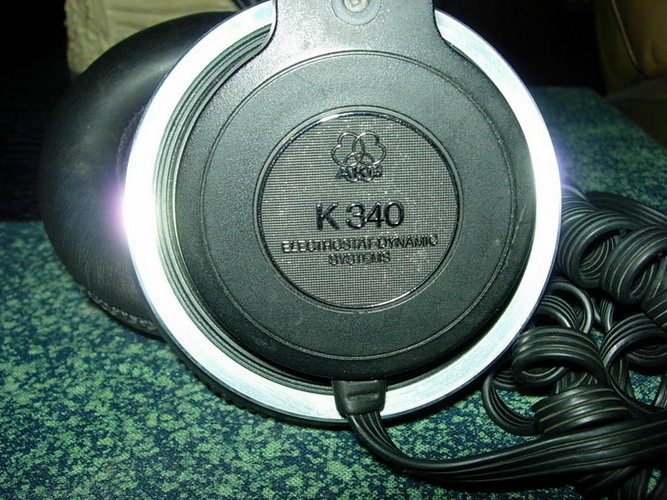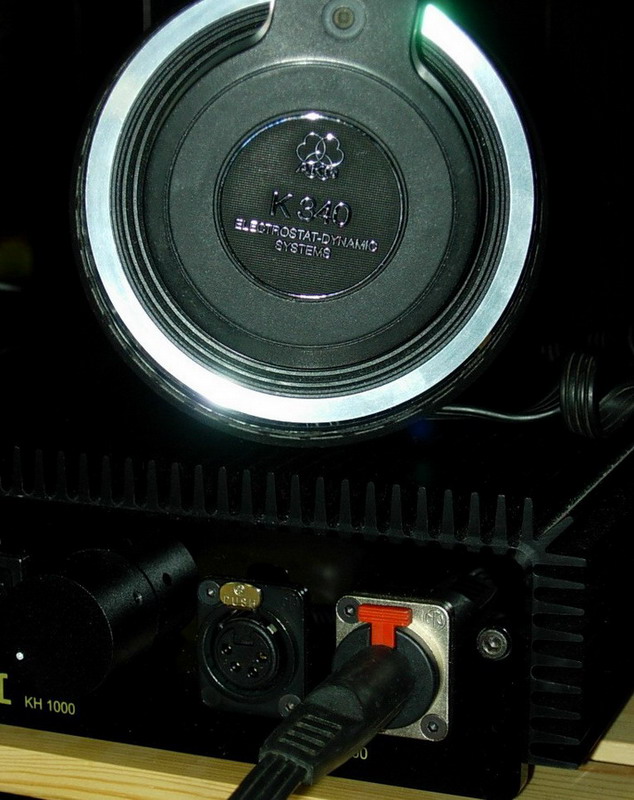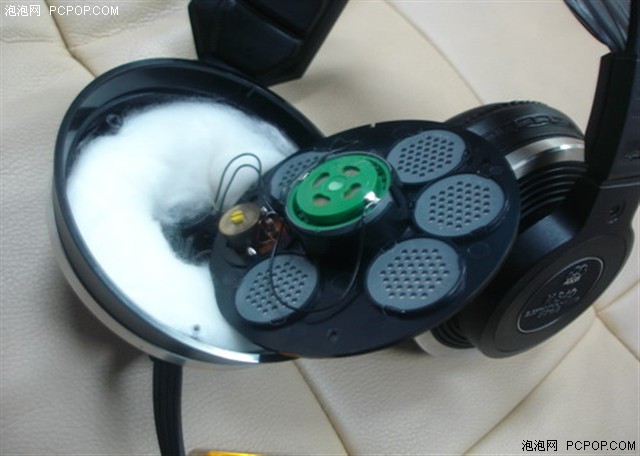|
|
感谢关注耳机俱乐部网站,注册后有更多权限。
您需要 登录 才可以下载或查看,没有账号?注册

x
最近收到了一只AKG的静电耳机K340。一只已经尽30岁,但是声音依旧完美,且敢于抗衡当今新机的老耳机。欣喜之余,查阅了一下他的资料,感觉收获很大,贴出来,与诸位烧友共享:
市面上唯一动圈静电合体耳机:

一、1978年,AKG的又一个经典耳机K340推出了,它采用了一个动圈单元和一个驻极体(Electret)单元。驻极体耳机是静电耳机的一种,也叫固定式静电耳机,它的振膜本身就是极化的或者由振膜外极化物质发射的静电场极化,不需要专门设备提供极化电压。4KHz以上的信号由K340的驻极体单元负责重放,取驻极体单元高频瞬态好、延伸好的特点。由于驻极体单元的阻抗极高,K340用了一只小型变压器来实现阻抗变换,驻极体单元与动圈单元直接并联。4KHz以下的信号由动圈单元负责重放,这只动圈单元采用了真空喷镀技术在聚酯表面镀了一层20um厚的金,使得振膜刚性好,不产生分割失真。K340还使用了从振膜系统,主动振膜即动圈单元的周围有5个从振膜,第6个从振膜的位置安装了阻抗变换用的变压器。在200Hz以下从振膜关闭,耳机按封闭式原理工作,低频丰满、可下潜至16Hz;200Hz以上从振膜开放,耳机按开放式原理工作,避免了封闭式耳机低频上段的不自然提升。而且这6个从振膜的相位略有差异,每个从振膜的打开都略有一些延迟,这是通过从振膜后面的声阻尼元件来作用完成的,这样就形成了一些振幅很小间距为几微妙的脉冲,模拟人的耳廓相应,可得到良好的空间感。K340是一个8振膜,声学3分频的耳机系统,阻抗400欧姆,灵敏度94dB/mW,频率响应16Hz—25KHz。
二、1993年AKG停产了K340耳机,同样采用静电和动圈混合的耳机还有1984年的K145和1981年的K4 HiFi耳机。现在二手市场上偶尔还会看到K340的身影,它已经是耳机爱好者们追求的收藏品了。一般来说驻极体的寿命为5-10年,驻极体会慢慢去极化,耳机的声音变小,频率特征变差,最后完全不能使用,必需更换新的驻极体振膜。K340采用了特殊的工艺和极稳定的材料,可以使用30-40年没有明显的声音劣化,这与AKG在驻极体话筒制造方面的经验不无关系。
三、K340是一个半开放耳机,个头很大,工艺精细,佩戴很舒适,在包装上AKG也下了功夫,做了保护单元的塑胶罩和包装耳机的发泡材料盒。
四、K340的驱动不算难也不算容易,它声音是AKG的传统声底与现代风格的结合,声音素质介于K240DF和K1000之间,性格与K1000十分接近,它的优势并不在于高频的延伸,而在于中频的圆润饱满和亮泽,没有一丝毛刺,十分的舒适宜人。它的声场宽大,声音平衡轻松自然,低频富于弹性,量感适中,但下潜稍欠,高频亦细腻光滑,延伸并不是特别好,毕竟驻极体振膜性能不能象普通静电耳机那样好。与K240DF相比它的声音庞大润泽而轻松;与K1000相比它的延伸、密度、解析力都有所不足,高频不如K1000那样纤细,中频欠密实,低频不如K1000庞大有力。
下面,我们继续了解下340的版本区分:k340存在两个版本,区别在头带上,一种带akg字样,是加重低音的美国版,俗称低音版,低音强力,但是中高频不如另外一个俗称高音版的亮丽而舒展;另一种不带akg字样,俗称高音版,中高音强,而低音力度较弱。低音版经常被烧友改变接线顺序以提高低频。而高音版经常被烧友音,把后面的棉花掏空,把后面的棉花掏空,用那种黑色得比较厚能导电的胶带堵住后面的空洞,以削弱低音使耳机更加平衡。这都是相对普遍的玩法。因此,历经30年,市面上完美完好的340耳机几乎难觅踪迹。
最后,我们看看相关的外文说明和评价:
The Sextett is the original version of the K240, first made in 1975. It differs from the later versions in that it makes use of a ring of variously-tuned "passive radiators," which are like little driver membranes without voice coils behind them. This tricky and expensive device (also used in a few other AKG headphones of the time, most notably the K340) gives a very precise control over how the acoustic backwave returns to the listener's ear, crucial for spatial presentation and general frequency response. Later K240 lacking this ring of six passive radiators are generally considered sharply inferior to the original version.
As has been noted above, the Sextett can be identified by the color of the metal rings on the earpieces (silver not gold), by the large round perforations in the headband, and by the appearance of the inner side of the earpiece, where the passive radiators are visible behind a plastic grill, encircling the driver.
They were very expensive to make.
It costs a lot of money to put six passive radiators on a headphone, plus a grille to protect them.
As we heard it, there was a lot of infighting at AKG over whether the same job could be done 90% as well by just putting six patches of semipermeable filter material on the baffle instead of six passive radiators (which also have filter material on their backside).
Eventually they released that concept as the K241, which used the same baffle as the late production K240 but with no passive diaphragms, and two different densities of filter paper.
The pro audio market apparently accepted the K241 as being within spitting distance of the K240 Sextett, so they replaced the K240 with the K240 Monitor, discontinued the K241, and then (in some markets) continued to market the Sextett for a while as the K242.
Since then, the technique of putting filtered vents on the baffle has been copied by basically everybody who's ever manufactured headphones, to varying levels of success.
After a while the K240-M went from six big patches to a larger number of smaller patches, closer to the driver. We don't know quite as much about the evolution of the K240-M over the years because we don't care much. The K240-DF has woven rather than nonwoven filter patches.
Edit: oh, and as for "superior", there is certainly a level of refinement and detail in modern AKGs that wasn't there 30 years ago, but the sextett models are unquestionably very enjoyable to listen to, and have better bass than most AKGs.
As we heard it, there was a lot of infighting at AKG over whether the same job could be done 90% as well by just putting six patches of semipermeable filter material on the baffle instead of six passive radiators (which also have filter material on their backside).
Eventually they released that concept as the K241, which used the same baffle as the late production K240 but with no passive diaphragms, and two different densities of filter paper.
从上面这段文字看,AKG由于在SEXTETT上采用的低频无源辐射器结构过于复杂,制造成本高昂,内部争议也很大。关于到底是使用低频无源辐射器(低频无源辐射器后部亦为过滤材料)还是采用六个半透性滤膜来实现其九成效果惹起了很多内部争论。后来它们最终以该概念推出了K241,该耳机采用了与后来K240系列同样的障板但未采用被动震膜,它也采用了两种不同密度的滤膜。如此看来,只有SEXTETT是采用完整的低频无源辐射器结构的,其他的都不再采用这个结构了。LZ的SEXTETT确实是好东西了,它作为最初的技术原型,是AKG追求极致音效的成果。但这种结构过于复杂和先进的东西成本过大,为了平衡成本的效果,它只能在可接受的成本范围内尽量实现SEXTETT这一原型的效果,也就是只能达到SEXTETT九成的效果而已。AKG后来推出的产品也是多了很多折衷,包括现在K701的双震膜,和K271S上的摩擦片技术。K241的技术应该更为接近现在的摩擦片技术了。
综上所述,K340是一只非常优秀又富于传奇色彩的耳机,他在akg的历史中,起到了承前启后的作用。无论它的神秘构造和近乎完美的人声表现,都使它成为akg迷必须拥有的收藏品之一。以往,由于340的功力很难正常发挥,使得一些老烧对他也不尽头痛,功放、耳放,万般能耐使尽,他依然我行我素。然而在30年后的今天,因了kh1000的出现,老机焕发了青春,这对忘年交的融合度达到了以往前所未有的高度,在这个价位,终于也让贫民发烧友真实领略了akg的风采,做到了低价同样发烧
耳机类型 有线动圈耳机
耳机佩戴方式 头戴护耳式
频响范围 16Hz-25kHz
阻抗 360欧姆
灵敏度 104dB
缆线长度 3m




|
|